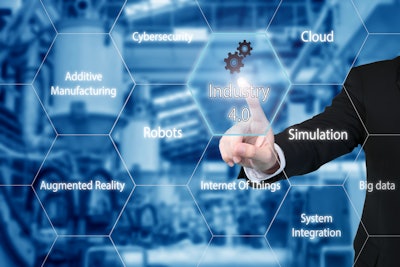
Industry 4.0 generated a wave of general-purpose horizontal solutions and technologies. Still, clean domain, specific purpose-built vertical solutions can turn this trend into a sustainable success for the supply chain industry.
The Rise of Industry 4.0
We live amid a digital revolution transforming how we produce, consume and interact. This revolution, known as Industry 4.0—the fourth industrial revolution—is characterized by integrating digital technologies, such as artificial intelligence (AI), cloud computing, big data and the Internet of Things, into industrial processes and systems. In the supply chain area, Industry 4.0 aims to create a smart supply chain that is more efficient, flexible and responsive to customer needs and market changes.
But Industry 4.0 also brings new challenges and opportunities for businesses and customers: How can an organization adapt to the fast-changing and complex supply chain landscape?
The Difference Between Horizontal and Vertical Solutions
The answer lies in the choice of solutions that can help businesses and industries cope with the challenges and opportunities of Industry 4.0.
There are two main types of solutions: horizontal and vertical. Horizontal solutions can be applied across different industries and domains, such as cybersecurity, AI, data analytics or cloud services. Vertical solutions are tailored to the specific needs and challenges of a particular industry or domain, such as supply chain, healthcare, manufacturing or agriculture. Horizontal solutions tend to be more generic and scalable, while vertical solutions are more customized and specialized.
For example, generative AI chatbots are comprehensive horizontal solutions. In contrast, a customized solution for the logistics industry is a particular vertical solution that will help adapt and solve the problem for that domain faster.
Transformation From Horizontal to Vertical
Vertical solutions can address a particular industry or domain's pain points and challenges. These solutions can leverage the domain expertise and knowledge of the industry or domain and provide more accurate, relevant, and actionable insights and recommendations.
Therefore, vertical solutions can help businesses and industries cope with the challenges and opportunities of Industry 4.0 and achieve their goals and objectives more effectively and efficiently.
While horizontal solutions offer many advantages and benefits that can help them thrive in the Industry 4.0 era, vertical solutions are more attractive and relevant for businesses and industries that operate in a specific domain and enable sustainable faster adoption.
Take-off vs. Cruising at 40,000 Feet
Horizontal and vertical integration are two complementary strategies that can enable the transformation of industries and domains in the era of Industry 4.0.
Horizontal integration is like the take-off phase of a flight, where different technologies and data sources are combined and integrated across various domains and sectors, creating new possibilities and opportunities for innovation and value creation.
Vertical integration is like the cruising phase of a flight, where the different layers and components within a specific domain or industry are aligned and coordinated, ensuring the optimal performance and efficiency of the solutions and services delivered to the end customers.
How Customers Benefit
Customer can shorten the time it takes for new technologies to make a difference in their business with vertical integration. Combining vertical and horizontal strategies is transforming corporations globally. Customers can improve their top-line and bottom-line performance by using AI and data in their current value chain. They can also leverage external partners who can utilize the ecosystem and provide more value to their customers and end-users.
There are many living proofs of this transformation, as most companies are not defined by their traditional sectors, such as car manufacturing, retail, banking, or real estate. They are all becoming technology companies that deliver innovative solutions and experiences to their customers.
Why Waiting Alone Isn't a Strategy
Waiting for the technological wave to stabilize on its own may not be a viable or desirable option for the organization or service provider in the supply chain industry.
The horizontal wave is driven by the rapid and continuous development and innovation of technologies and data sources, which are often influenced by factors and forces beyond the control and influence of the industry players. Moreover, the horizontal wave may also create disruptions and challenges for the existing solutions and services, as well as the expectations and demands of the end customers.
It’s important to proactively embrace the horizontal wave rather than passively waiting for it to settle down. By doing so, companies can create more value and impact for themselves and their end customers and stay ahead of the competition and the changing market dynamics.
Supply Chain Customer Industry Opportunity and Responsibility
In our industry, integrators and OEMs have a unique responsibility and opportunity to drive the horizontal technological wave into sustainable vertical solutions for the end customers. They can:
- Leverage their knowledge and expertise of the industry or domain and their relationships and networks with suppliers, partners and customers to create customized and tailored solutions that can deliver more value and impact.
- Help the end customers achieve their goals and objectives more effectively and efficiently and cope with the challenges and opportunities of Industry 4.0.
- Enhance their competitive advantage and differentiation in the market by offering innovative and relevant solutions to meet the end customers' evolving and dynamic needs and expectations.
![E2[20] Headshot](https://img.sdcexec.com/files/base/acbm/scn/image/2023/12/E2_20_.656a0cc0477b4.png?auto=format%2Ccompress&crop=faces&fit=crop&h=48&q=70&w=48)




![Top Tech Logo Vertical [color]](https://img.sdcexec.com/files/base/acbm/scn/image/2023/12/top_tech_logo_Vertical__color_.656e286049642.png?auto=format%2Ccompress&fit=crop&h=167&q=70&w=250)
![2023 Top Software Color[vertical]](https://img.sdcexec.com/files/base/acbm/scn/image/2023/10/2023_TopSoftware_color_vertical_.653a8505cd258.png?auto=format%2Ccompress&bg=fff&fill-color=fff&fit=fill&h=167&q=70&w=250)













